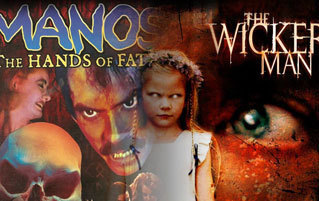5 Signs You're Watching the Awesome Kind of Bad Movie

You've probably been in this situation before: You see a movie on Netflix with an awesome name, like Santa Claus Battles the Demon Unicorns. Your friend convinces you that you should watch this movie together, because it's going to be "so bad it's good." You sit down, put it on, and awkwardly pretend to have fun watching a character actor, who's obviously battling alcoholism in real life, mumble his way through some bad dialogue. Thirty minutes in, you snap and bludgeon your friend to death with the popcorn bowl. Throughout the murder trial you ponder whether the phrase "so bad it's good" has any meaning at all anymore.
Part of this confusion comes from the phrase itself: "So bad it's good" implies that once a movie dips below a certain level of quality, it somehow automatically shifts into the "good" category. If this were the case, channels like SyFy and Lifetime would be the most celebrated forms of entertainment in America. But they're not, and that's because, to achieve true good-badness, movies must follow a surprisingly complex series of rules. For example ...
They're Not the Same as "Intentionally Bad"
The "so bad it's good" label is often thrown around to describe the cheap, low-quality movies that flood today's Netflix accounts and Redbox machines. These kinds of films, sometimes called B-movies (because they traditionally formed the less-worthy half of a cinematic double billing), were popularized in the 1950s by a production company called America International Pictures. AIP had a unique way of making movies: First, they'd come up with a title that sounded awesome, like I Was a Teenage Werewolf or Terror from the Year 5000. Then they'd commission a poster to match it. Finally, once the truly important stuff was out of the way, they'd hurriedly fart out the actual film.

the people in the movie comment section got really angry.
This title-comes-first, budget-and-quality-come-last method was so successful that it's still being used today by production companies like the Asylum, the guys responsible for such recent titles as Nazis at the Center of the Earth and 2-Headed Shark Attack. The Asylum gets a great deal of business from people seeing these awesome titles and saying, "Zombies vs. Squirrel Ninjas? Whoa, that must be so bad it's good."

These viewers inevitably wind up disappointed, though, because Asylum-style B-movies almost never follow the crucial rules of good-bad movies. Like ...
They Should Succeed on Some Level
In Anna Karenina, Tolstoy wrote: "All happy families are alike; each unhappy family is unhappy in its own way." Of course, he was talking about life in 19th century Russia, when they presumably had a greater variety of fatal STDs to keep things interesting than we do now. But the idea still endures that good things are generally monotonous and dull, whereas bad things are terrible in unique, interesting ways. So if a movie looks awful or ridiculous, it must have something inherently interesting about it. This is complete bullshit.

What makes Jurassic Park enjoyable isn't the same thing that made No Country for Old Men a success. The Avengers and The Seventh Seal are not good for the same reasons. But bad movies? Almost always, bad movies are bad in the same way. The acting sucks. The monsters are stupid looking. The ghost shark is just phoning in his lines. It's duller than watching a plant die. And yet these dull B-movies keep making money, because every time we come across a new one (Amish Vampires vs. a Yeti! A Giant Tsunami of Velociraptors!), we convince ourselves that this one will be different.
What we're forgetting is that for a movie to be enjoyably bad, it must also be a success. Remember "Friday" by Rebecca Black? It was a terrible song, yes, but it was also a successful song, because it did what a pop song is meant to do: It got into your head and wouldn't leave.

Similarly, a good-bad movie should succeed at its job: It should entertain us for 90 minutes. And this achievement is so rare that it's almost impossible. For every Troll 2 or The Wicker Man, there's a thousand bad movies that sank like dead two-headed sharks because they were terrible and boring.
How do some bad movies manage to avoid this and achieve greatness, then?
They Should Keep Surprising Us With Their Awfulness
Most straight-to-DVD movies and pieces of Netflix detritus fail because the badness of the average bad movie is static. For example, SyFy movies produced by the Asylum usually involve a giant monster of some sort, usually based on a shark:
That's pretty entertaining ... but it's like one minute of the movie, and the film as a whole doesn't really offer much else. No joke is funny if you keep repeating it for 90 minutes. To reach "so bad it's good" territory, a movie needs to continually escalate its badness. For example, let's take Birdemic, widely celebrated as one of the greatest "so bad it's good" movies of all time. The badness of this movie is like the subject of a long Internet argument: Just when you think you've grasped it, it morphs into something else.

is a straw man argument. It's laughably obvious that ..."
Birdemic starts with some terrible acting: Sure, that's amusing for about five minutes. But then comes the scene where the protagonist invents a solar panel that would single-handedly solve the world's energy problems, and everyone around him reacts like this is no big deal. Soon afterward, mutant birds appear that are made from those animated gifs they had on websites back in 1995, and then the birds start exploding and making cute little dive bombing noises while they do it. And it just keeps going. Amazingly, Birdemic pulls off this badness roller coaster for its entire runtime.
Of course, the boundaries of this rule are blurry, because not everyone is entertained by the same thing. Some people think Batman & Robin and Die Hard 4.0 successfully climb the "so bad it's good" mountain; for others, they're just bad. I enjoyed the Twilight movies on this level; a lot of people enjoyed them about as much as sticky floor popcorn that a hobo's been sleeping on. But it's important to realize that good-bad movies are like those trips to the dentist where they offer you a bunch of different of flavors of fluoride gel that all taste like butt: They should be varied in their terribleness. Another important rule is ...
They Should Give Us Insight into the Creator's Insanity
If truly good-bad movies aren't produced by the Asylum or the like, who makes the damn things? They're almost always produced by people who thought they were making good movies.
No matter what good-bad movie you're talking about, there was at least one person on set who thought that the movie is going to be great. In Troll 2, it was the Italian husband-and-wife director-writer team, who wrote their script in English despite hardly speaking the language. In The Wicker Man, it was Nicolas Cage, who poured everything he had into that scene with the bees. In The Room, it was director Tommy Wiseau, who seemed to think the story he was telling was a life-changing masterpiece.

No one involved in 2-Headed Shark Attack thought their movie was going to be great. Good-bad movies, on the other hand, have an innocence behind them that is almost endearing. We all like to watch movies that give us a peek into the minds of people completely unlike ourselves. Through the magic of cinema, we can experience life as a serial killer or a narcissist or a madman or someone from Canada. But most of these movie experiences are filtered through the viewpoint of a completely sane director and cast. Good-bad movies cut out this middleman and plug us directly into the brain noise of someone who thought that this was how Americans play football.

Which is why, when Birdemic 2 was released in 2013, it just wasn't as enjoyable as the original. Director James Nguyen made the sequel years after his movie had been proclaimed one of the worst ever made, long after even the densest ego could possibly believe that they were making another daring pro-environment masterpiece. The weird innocence of the original was replaced by a director adding zombies and shit in an actual attempt to be bad, and that's just not as fun.
They Should Teach Us a Lesson
No matter what you do for a living, you've probably experienced people underestimating how difficult your job is. If you have a degree in cat shaving and 10 years of experience shaving cats at your cat-shaving business, customers will still tell you that you're shaving cats wrong. If you are a professional Frisbee player, you'll have to deal with random people telling you that they could totally personally improve on your Frisbee technique, if only they chose to get up and throw the Frisbee rather than sit on the sidelines eating a waffle taco.

This attitude is particularly common when it comes to creative stuff. A friend dismisses your life-size mural of a kitten riding a dragon; they could do it better, you know, if they wanted to. Relatives claim that playing the harmonica must be easy because you do it so well, ignoring all your long nights slaving away at harmonica school. Movie making is no different: A lot of people have the attitude that a director just points cameras at stuff, and everything else works itself out.
This is where bad movies come in. Most good-bad movies were made by the film industry version of the waffle-eating guy picking on your Frisbee game. For example, rumor has it that the famed 1966 good-bad movie Manos: The Hands of Fate was actually the result of a bet somebody made with the director after he boasted that movie making was no big deal, anyone could do it. The result was this:
Watching Manos is like attending a reverse filmmaking school. It's a level of bad that most of us non-filmmakers never imagined could exist, because we've never seen that far behind the scenes of that particular creative process. Moths fly at the screen because of the lights the crew was using at night. Entire scenes are out of focus. Whole shots are blocked by the back of an actor's head. Manos is an extreme example, but most good-bad movies tend to have been vomited out by people who both overestimated their own skills and underestimated the difficulty of making a good film. Watching these movies is like vicariously dragging Waffle Taco Guy up and forcing him to throw a Frisbee at a professional level, and then watching him cry as his Frisbee goes off course and knocks over a fruit stand.
Furthermore, good-bad movies teach us to appreciate qualities in movies that were formerly invisible. Sure, they have a whole Oscar category for sound mixing, but if you really want to appreciate what good sound mixing does for a movie, watch this scene in Birdemic fail at it. We might laugh at a wooden performance or two in a blockbuster, but we don't realize just how good most actors in movies are until we watch The Room. Sure, the last Hobbit movie kind of sucked, but at least no one got hit in the face with a boom mic.
